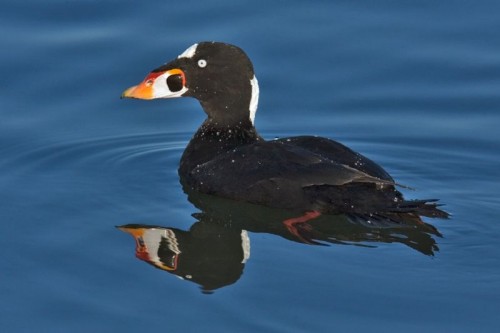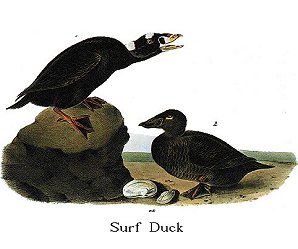Bonus pervious nostril!
 I’ve been working hard on pieces for the San Diego Audubon Birding Festival, which is coming right up. While glazing a wall tile with the portrait of a male Surf scoter and looking at photo resources of scoters, I realized I was being treated to another pervious nostril!
I’ve been working hard on pieces for the San Diego Audubon Birding Festival, which is coming right up. While glazing a wall tile with the portrait of a male Surf scoter and looking at photo resources of scoters, I realized I was being treated to another pervious nostril!
It doesn’t show so much in this photo, but scoters, like cathartid vultures, have pervious, or “see-through” nostrils. In Audubon’s professionally terse words:
Nostrils sub-medial, elliptical, large, pervious, near the ridge.
–John James Audubon, Birds of America, Family XXXIX. ANATINAE. DUCKS. GENUS V. FULIGULA. SEA-DUCK.
If you don’t know scoters, they’re sturdy North American sea ducks who breed in Alaska and northern Canada and winter along both coasts of the U.S. They dive for a living. The picture above, by photographer Alan D. Wilson, is a male Surf scoter (Melanitta perspicillata) at Bolsa Chica reserve, in California. It shows the handsome bird with what is too frequently described as a “clownish bill”, gliding in the blue backwater of Bolsa Chica Wetlands. If you’re wondering why the “clownish bill” is so big, scoters eat hard food, some of which — like blue mussels — needs to be pried off of rocks underwater. In summer, they favor marine invertebrates, in winter, mostly molluscs.
As for the pervious nostril in scoters, I haven’t turned up a definitive discussion yet, but most sea birds need to rid their systems of salt, often by sneezing or dribbling it out through the nostrils, and have evolved various nostrillar adaptions (again, a technical term) to do so: pervious nostrils would not easily become clogged with expelled salt crystals.
To the left is Audubon’s plate of Surf scoters — at the time called Surf Ducks — from Birds of America
Three Star Owl will be at the San Diego Birding Festival in Mission Bay San Diego, 5-8 March 2009.

[…] suffering birds, fortunately, but we did see a number of loons, grebes, and sea-going ducks like scoters cruising the near-shore waves on beaches covered with blowing clots and rolls of sticky […]